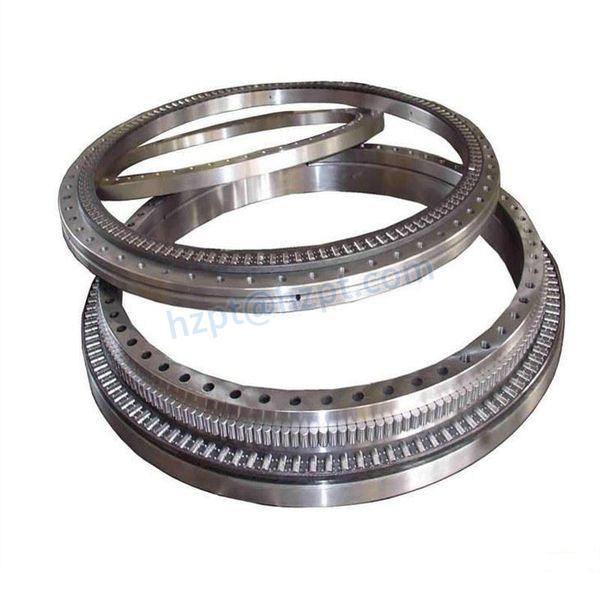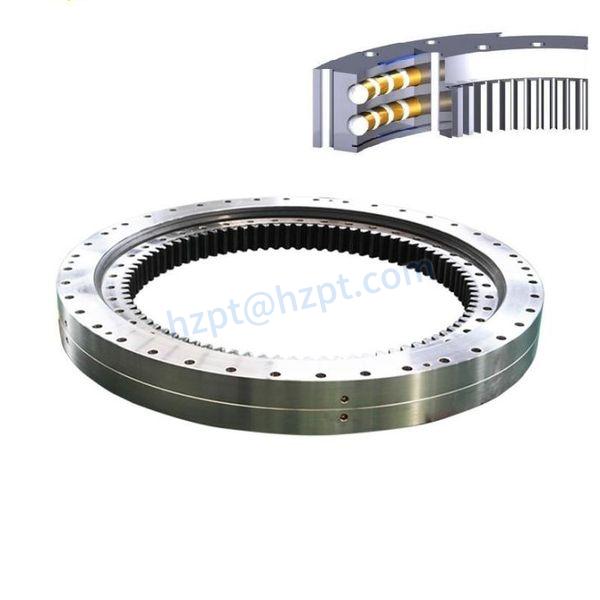Product Description
Large Non-Standard Customized Marine Crane Toothless Slewing Bearing Introduction:
large non-standard customized slewing bearings without gears are essential components in heavy-duty industrial machinery and equipment, providing reliable rotational support for various applications across multiple industries.
Large Non-Standard Customized Marine Crane Toothless Slewing Bearing key features:
-
Customization: These slewing bearings are tailored to meet specific design requirements, including size, load capacity, mounting arrangements, and environmental conditions. This customization ensures compatibility with the intended application and seamless integration into the equipment.
-
High Load Capacity: Large non-standard slewing bearings are engineered to support exceptionally heavy loads while maintaining stability and smooth rotation. They are constructed using high-strength materials and advanced manufacturing techniques to withstand the rigors of industrial operations.
-
Precision Engineering: These bearings are manufactured with precision machining and assembly processes to achieve tight tolerances and ensure smooth, reliable rotation. This precision engineering minimizes friction and wear, resulting in extended service life and reduced maintenance requirements.
-
Corrosion Resistance: Depending on the application requirements, large non-standard slewing bearings can be treated with corrosion-resistant coatings or made from stainless steel to withstand harsh operating environments, including exposure to moisture, chemicals, and contaminants.
Large Non-Standard Customized Marine Crane Toothless Slewing Bearing Display:
/* January 22, 2571 19:08:37 */!function(){function s(e,r){var a,o={};try{e&&e.split(“,”).forEach(function(e,t){e&&(a=e.match(/(.*?):(.*)$/))&&1
| Standard or Nonstandard: | Standard |
|---|---|
| Feature: | Corrosion-Resistant |
| Sealing Gland: | Sealed On Both Sides |
| Rolling-Element Number: | Single-Row |
| Roller Type: | Straight Raceway |
| Material: | Bearing Steel |
| Samples: |
US$ 10/Piece
1 Piece(Min.Order) | |
|---|
| Customization: |
Available
| Customized Request |
|---|

What Role do Seals and Enclosures Play in Protecting Slewing Bearings from Contaminants?
Seals and enclosures play a crucial role in safeguarding slewing bearings from contaminants, moisture, and other external factors that can lead to premature wear and damage. Here’s how seals and enclosures contribute to the protection of slewing bearings:
- Contaminant Exclusion:
Seals and enclosures create a physical barrier that prevents contaminants like dust, dirt, sand, and particles from entering the bearing’s internal components. This exclusion minimizes abrasive wear and preserves the integrity of the rolling elements and raceways.
- Moisture and Corrosion Prevention:
Seals and enclosures provide a shield against moisture and water ingress, crucial in preventing corrosion and rust formation on bearing surfaces. Corrosion-resistant seals are particularly valuable in marine and humid environments.
- Chemical and Chemical Vapor Resistance:
Specialized seals and enclosures can offer resistance to chemicals, acids, and corrosive substances that might be present in the operating environment. This protection prevents chemical damage to the bearing’s components.
- Lubrication Retention:
Seals and enclosures help retain the lubricant within the bearing, preventing it from leaking out and ensuring consistent lubrication for smooth operation. This is essential for reducing friction and wear.
- Prevention of Solid Particle Contamination:
Seals and enclosures block solid particles from entering the bearing chamber, reducing the risk of particle-induced wear, surface damage, and premature failure.
- Temperature Regulation:
Some seals and enclosures offer thermal insulation, which helps regulate the operating temperature of the bearing. This can be crucial in applications with extreme temperature variations.
- Enhanced Longevity:
By protecting the bearing from contaminants and adverse environmental conditions, seals and enclosures contribute to the extension of the bearing’s operational life, reducing the need for frequent replacements.
- Sealing Types:
Seals can come in various types, including lip seals, labyrinth seals, and specialized designs. The choice of seal depends on the application’s requirements and the level of protection needed.
- Proper Installation and Maintenance:
Proper installation and regular inspection of seals and enclosures are essential to ensure their effectiveness. Damaged or worn seals should be promptly replaced to maintain protection.
In summary, seals and enclosures serve as a critical defense mechanism for slewing bearings against contaminants, moisture, and harmful substances. They contribute to the bearing’s reliability, performance, and overall longevity in various operating environments.

What are the Common Maintenance Practices for Ensuring the Durability of Slewing Bearings?
Maintaining slewing bearings is crucial for ensuring their longevity and optimal performance. Here are some common maintenance practices to enhance the durability of slewing bearings:
- Regular Inspection:
Perform routine visual inspections to check for signs of wear, corrosion, and damage. Inspect seals, lubrication levels, and any unusual noises or vibrations during operation.
- Lubrication:
Follow the manufacturer’s guidelines for lubrication intervals and use appropriate lubricants. Lubricate the bearings to ensure smooth operation, reduce friction, and prevent wear.
- Seal Maintenance:
Inspect and maintain seals to prevent the ingress of contaminants such as dust, dirt, and moisture. Damaged or worn seals should be replaced promptly.
- Cleaning:
Regularly clean the bearing and its surrounding area to remove dirt, debris, and contaminants that could affect performance. Keep the bearing environment as clean as possible.
- Environmental Protection:
If the bearings are exposed to harsh conditions, consider using protective covers or shields to prevent direct exposure to elements like water, chemicals, and abrasive materials.
- Alignment and Mounting:
Ensure proper alignment during installation to prevent unnecessary stress on the bearing. Accurate mounting reduces the risk of misalignment-related failures.
- Torque Monitoring:
If the bearing has gears, regularly monitor and maintain the torque levels to prevent overloading and premature wear.
- Load Distribution:
Operate the machinery within the specified load limits to avoid overloading the bearing, which can lead to fatigue and failure.
- Replacement of Worn Components:
If any components, such as seals or lubrication fittings, show signs of wear, replace them promptly to maintain the integrity of the bearing system.
- Documentation:
Maintain records of maintenance activities, including lubrication schedules, inspections, and any repairs or replacements. This documentation helps track the bearing’s history and aids in decision-making.
- Training:
Ensure that maintenance personnel are adequately trained to carry out proper inspection, lubrication, and maintenance procedures.
By implementing these maintenance practices, you can maximize the service life of slewing bearings, minimize downtime, and maintain consistent machinery performance.

How do Different Types of Slewing Bearings Vary in Terms of Design and Function?
Different types of slewing bearings vary significantly in terms of their design and function, catering to diverse industrial requirements. Some common variations include:
- Single-Row Ball Slewing Bearings: These bearings consist of a single row of balls positioned between two rings. They are compact and suitable for light to moderate axial and radial loads, making them useful in applications like small cranes and excavators.
- Double-Row Ball Slewing Bearings: These bearings have two rows of balls and higher load-carrying capacity compared to single-row types. They find use in applications requiring higher loads and moment resistance, such as larger cranes and construction machinery.
- Three-Row Roller Slewing Bearings: These bearings use cylindrical rollers to handle heavy axial, radial, and moment loads. They are commonly found in heavy-duty applications like harbor cranes and mining equipment.
- Cross Roller Slewing Bearings: These bearings have cylindrical rollers arranged in a crossed pattern between the inner and outer rings. They offer high stiffness and precision, making them suitable for applications like robotic arms and precision machinery.
- Wire Race Slewing Bearings: These innovative bearings use a thin wire race to support the rolling elements. They are lightweight and compact, often used in medical equipment and aerospace applications.
- Ball-And-Roller Combination Slewing Bearings: These hybrid bearings combine ball and roller elements to achieve a balance between load capacity and precision. They find use in various industrial machines and equipment.
- Gearless Slewing Bearings: In some applications, slewing bearings incorporate no gears or teeth. They are used where external gear reduction is present or precise rotation isn’t required.
- Geared Slewing Bearings: These bearings include internal gears or teeth that allow torque transmission between the inner and outer rings. They are essential in applications requiring controlled rotation, such as cranes and wind turbines.
The choice of slewing bearing type depends on factors like load requirements, available space, rotational precision, and the specific industrial application. Understanding the variations helps engineers select the most suitable bearing for optimal performance.


editor by CX 2024-04-30
Leave a Reply